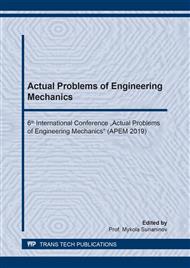[1]
P. Krivenko, Oleg, P., H. Vozniuk, S Lakusta, The development of alkali-activated cement mixtures for fast rehabilitation and strengthening of concrete structures. Procedia engineering, 195 (2017) 142-146.
DOI: 10.1016/j.proeng.2017.04.536
Google Scholar
[2]
P. Krivenko, Why alkaline activation–60 years of the theory and practice of alkali-activated materials. J. Ceram. Sci. Technol 8.3 (2017): 323-334.
Google Scholar
[3]
Caijun Shi, Della Roy, P. Krivenko. Alkali-activated cements and concretes. CRC press, 2003. https://www.taylorfrancis.com/books/9781482266900.
DOI: 10.1201/9781482266900
Google Scholar
[4]
A. Susan, and J. Provis, Durability of alkali activated materials: progress and perspectives. Journal of the American Ceramic Society 97.4 (2014): 997-1008.
DOI: 10.1111/jace.12831
Google Scholar
[5]
John L. Provis, Jannie S.J., van Deventer, P.V. Krivenko, E.S. Kavalerova and other. Alkali activated materials: state-of-the-art report, RILEM TC 224-AAM. Vol. 13. Springer Science & Business Media, (2013).
DOI: 10.1007/978-94-007-7672-2_2
Google Scholar
[6]
T. Kropyvnytska, R. Semeniv, H. Ivashchyshyn, (2017). Increase of brick masonry durability for external walls of buildings and structures. MATEC Web of Conferences. Vol. 116. EDP Sciences, (2017).
DOI: 10.1051/matecconf/201711601007
Google Scholar
[7]
P. Krivenko, Hailin Cao, O. Petropavlovsky, Luqian Weng, V. Pushkar, Effect of technology of manufacturing the alkali activated cement concretes: porous structure and frost résistance. proc. Of the International Conference Non-traditional cement & Concrete V,. Brno University of Technology, 2014, pp.119-122.
DOI: 10.4028/www.scientific.net/amm.525.556
Google Scholar
[8]
P. Krivenko, O. Petropavlovsky, O. Kovalchuk, A. Pasko, S. Lapovska, Design of the composition of alkali activated Portland cement using mineral additives of technogenic origin. J. Eastern-European Journal of Enterprise Technologies, 4/6 (94) (2018) 6-15.
DOI: 10.15587/1729-4061.2018.140324
Google Scholar
[9]
J. Labrincha, at all. From NORM by-products to building materials. Naturally Occurring Radioactive Materials in Construction: Integrating Radiation Protection in Reuse (COST Action Tu1301 NORM4BUILDING), 2017, 183-252.
DOI: 10.1016/B978-0-08-102009-8.00007-4
Google Scholar
[10]
O. Kovalchuk, V. Grabovchak, Y. Govdun, Alkali-activated cements mix design for concretes application in high corrosive conditions. MATEC Web of Conferences. Vol. 230. EDP Sciences, 2018.
DOI: 10.1051/matecconf/201823003007
Google Scholar
[11]
V. Omelchuk, G. Ye, R. Runova, I. Rudenko, Shrinkage behavior of alkali-activated slag cement pastes. J. Key Engineering Materials,761 (2018) 45-48.
DOI: 10.4028/www.scientific.net/KEM.761.45
Google Scholar
[12]
I.I. Rudenko, at all., Efficiency of redispersible polymer powders in mortars for anchoring application based on alkali activated Portland cements. J. Key Engineering Materials, 761 (2018) 27-30.
DOI: 10.4028/www.scientific.net/KEM.761.27
Google Scholar
[13]
R. Runova, V. Gots, I. Rudenko, O. Konstantynovskyi, O. Lastivka, The efficiency of plasticizing surfactants in alkali-activated cement mortars and concretes. MATEC Web of Conferences. Vol. 230. EDP Sciences, 2018.
DOI: 10.1051/matecconf/201823003016
Google Scholar
[14]
P.Kryvenko, H. Cao, O. Petropavlovskyi, L. Weng, O. Kovalchuk,. Applicability of alkali activated cement for immobilization of lowlevel radioactive waste in ion-exchange resins. J. Eastern-European Journal of Enterprise Technologies, 1/6(79) (2016) 40-45. DOI: http://dx.doi.org/10.15587/1729-4061.2016.59489.
DOI: 10.15587/1729-4061.2016.59489
Google Scholar
[15]
P.Krivenko, O. Petropavlovsky, O. Kovalchuk, A Comparative study on the influence of metakaolin and kaolin additives on properties and ctructure of of alkali-activated slag cement and concrete. J. Eastern European Journal of Enterprise Technologies. 1/6 (91) (2018) 33-39.
DOI: 10.15587/1729-4061.2018.119624
Google Scholar
[16]
P. Kryvenko, at all. Analysis of plasticizer effectiveness during alkaline cement structure formation. J. Eastern-European Journal of Enterprise Technologies, 4/6 (88) (2017) 35-41.
DOI: 10.15587/1729-4061.2017.106803
Google Scholar
[17]
I.I. Rudenko, at all. Efficiency of redispersible polymer powders in mortars for anchoring application based on alkali activated Portland cements. J. Key Engineering Materials, 761 (2018) 27-30.
DOI: 10.4028/www.scientific.net/KEM.761.27
Google Scholar
[18]
R.F. Runova, M.O. Kochevyh, I.I. Rudenko, On the slump loss problem of superplasticized concrete mixes. In. Proceedings of the International Conference on Admixtures - Enhancing Concrete Performance, 2005 pp.149-156.
Google Scholar
[19]
P. Krivenko, O.g Petropavlovskii, H. Vozniuk, S. Lakusta, The development of alkali-activated cement mixtures for fast rehabilitation and strengthening of concrete structures. J. Procedia Engineering 195 (2017) 142-146.
DOI: 10.1016/j.proeng.2017.04.536
Google Scholar
[20]
M. Sanytsky, T. Kropyvnytska, T. Kruts, O. Horpynko, I. Geviuk, Design of rapid hardening quaternary zeolite-containing Portland-composite cements. J. Key Engineering Materials, 761 (2018) 193-196.
DOI: 10.4028/www.scientific.net/KEM.761.193
Google Scholar
[21]
G. Kochetov, T. Prihna, O. Kovalchuk, D. Samchenko, Research of the treatment of depleted nickel-plating electrolytes by the ferritization method. J. Eastern-European Journal of Enterprise Technologies, 3/6 (93) (2018) 52-60.
DOI: 10.15587/1729-4061.2018.133797
Google Scholar
[22]
A. Fernández-Jiménez, I. Garcia-Lodeiro, O. Maltseva, A. Palomo, Hydration mechanisms of hybrid cements as a function of the way of addition of chemicals. J. Journal of the American Ceramic Society, 102(1) (2019) 427-436. URL:.
DOI: 10.1111/jace.15939
Google Scholar
[23]
O. Pluhin, A. Plugin, D. Plugin, O. Borziak, O. Dudin, The effect of structural characteristics on electrical and physical properties of electrically conductive compositions based on mineral binders. J. Matec Web of Conference, 116 (2017) 01013.
DOI: 10.1051/matecconf/201711601013
Google Scholar
[24]
I. Garcia-Lodeiro, V.C. Taboada, A. Fernández-Jiménez, A. Palomo, Recycling Industrial By-Products in Hybrid Cements: Mechanical and Microstructure Characterization. J. Waste and Biomass Valorization, 8(5) (2017) 1433-1440. URL:.
DOI: 10.1007/s12649-016-9679-x
Google Scholar
[25]
P. Krivenko, O. Petropavlovskii, H. Vozniuk, Alkaline aluminosilicate-based adhesives for concrete and ceramic tiles. J. Revista Romana de Materiale/ Romanian Journal of Materials, 46(4) (2016) 419-423.
Google Scholar
[26]
M. Alonso, A. Pasko, C. Gascó, O. Kovalchuk, J.A. Suarez, P. Krivenko, F. Puertas, Radioactivity and leachability in SCM-bearing alkali-activated matrices. J. Construction and Building Materials (Virtual special issue), 159 (2018) 745-754. https://doi.org/10.1016/j.conbuildmat.2017.11.119.
DOI: 10.1016/j.conbuildmat.2017.11.119
Google Scholar
[27]
P. Krivenko, O. Kovalchuk, A. Pasko, Utilization of industrial waste water treatment residues in alkali activated cement and concretes. J. Key Engineering materials, 761 (2018) 35-38.
DOI: 10.4028/www.scientific.net/KEM.761.35
Google Scholar
[28]
D.F. Velandia, C.J. Lynsdale, J.L. Provis, F. Ramirez, Effect of mix design inputs, curing and compressive strength on the durability of Na2SO4 -activated high volume fly ash concretes. J. Cement and Concrete Composites, 91 (2018) 11-20. URL:.
DOI: 10.1016/j.cemconcomp.2018.03.028
Google Scholar
[29]
X. Ke, M. Criado, J.L. Provis, S.A. Bernal, Slag-Based Cements That Resist Damage Induced by Carbon Dioxide. J. ACS Sustainable Chemistry and Engineering, 6(4) (2018) 5067-5075. URL:.
DOI: 10.1021/acssuschemeng.7b04730
Google Scholar


